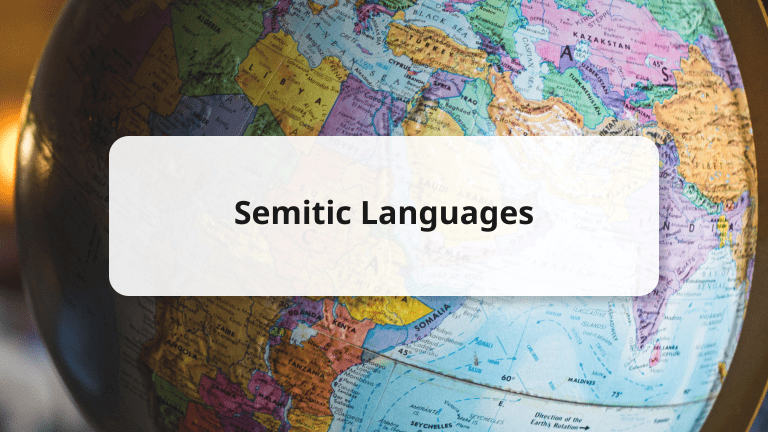Semitic languages, have you ever considered learning them? Well, you should. The subgroup is known as the Semitic language family and these are the languages that come to mind when you think of the Middle East and North Africa. If like many people, the first language that comes to mind is Arabic, you’re not wrong. However, if you think of Arabic like many people, you’re not wrong. There is actually a subgroup of more than 70 languages spoken primarily across North Africa and the Middle East by hundreds of millions of people. They are often ranked as some of the hardest languages to learn for English speakers.
If you’re looking to learn a language with over 5000 years of history then you’ve come to the right place. In this article, we will discuss the history of this language and acquaint ourselves with the top 7 Semitic languages. By the end of this article, you should be confident to say good morning in Arabic and goodbye in Hebrew. Let’s dive right in.
What are the Semitic Languages?
In the late 1700s, Johann Gottfried Eichhorn, a German theologian coined the term “Semitic” to describe this language family. He decided on this name as they connect to the Arabic, Hebrew and Aramaic languages. The word “Semitic” refers to “Semite,” which relates to the Biblical name meaning the oldest son of Noah.
The Semitic languages are old, they are among the earliest documented languages in the world. It includes a written history extending nearly 5 000 years, which doesn’t include pre-written history.
The system created in the language is very different from the systems that English speakers are used to. A peculiar feature of Semitic languages that is hard to grasp for non-native speakers is that words are based on the root of three consonants. By weaving vowels between the consonants, meaning can be derived.
| Language | Population | Country |
|---|---|---|
| Arabic | 450 million | United Arab Emirates, Morocco, etc |
| Hebrew | 10 million | Israel, Poland, United States |
| Amharic | 29 million | Ethiopia |
| Tigrinya | 7 million | Eritrea, Uganda, Canada, Germany, Italy, UK |
| Tigre | 1 million | Eritrea, Sudan |
| Aramaic | 500 thousand | Syria, Iran, Iraq, Turkey, Lebanon, Armenia, Georgia |
| Maltese | 525 thousand | Malta |
7 Most Famous Semitic Languages
Arabic
Arabic is the sixth most spoken language in the world. It varies greatly from the English language as Arabic uses a completely new alphabet and there is almost no shared vocabulary between Arabic and Latin-based languages. This Semitic language uses a highly inflectional tongue, meaning that subject, tense, and mood are communicated by how you inflect your tone. Although this language may seem daunting to undergo, finding Online Arabic Courses can make learning the language pleasantly engaging and will make the experience all the more rewarding. Once you become accustomed to Arabic, learning other Semitic languages will be a breeze.
Hebrew
Hebrew is an ancient and unique language and is commonly considered to be a holy language. It’s similar to other Semitic languages, like Arabic and Aramaic, as it has no vowels and is based on a three-letter root word. Although they have different scripts, they have parallel grammar systems. Hebrew is read and written from right to left as opposed to the English rule of reading and writing from left to right. Despite Hebrew having a completely different alphabet to that of English, learning the 22 letters is phonetically easy.
Amharic
Amharic is the official language of Ethiopia, mostly spoken around the central highlands of Ethiopia, and is considered the second most widely spoken Semitic language in the world after Arabic. The name Amharic comes from the district of Amhara in northern Ethiopia, which is thought to be the historic center of the language. In Amharic script, there are about 317 different alphabets including 238 core characters, 50 specialized pronunciation characters, 9 punctuation marks, and 20 numerals which are written and read, as in English, from left to right.
Tigrinya
Originally developed for the now-extinct Ge’ez language, Tigrinya is written in the Ge’ez script. the English language, It is written and read from left to right. Although the Ge’ez script looks difficult at the beginning, it does not take long to learn how to read in Tigrinya. There are 32 sets of letters in the Tigrinya alphabet and Pronunciation is very simple and straightforward. In Tigrinya “You write as you read it and you read as you write it”. In fact, You will be surprised to find many familiar words Tigrinya has borrowed from other languages. You’ll find Italian words such as “pasta” and English words such as “computer.”
Tigre
Tigre, Along with Tigrinya, is believed to be the most closely related living language to the now-extinct Ge’ez language. In fact, they are so similar that Tigre has a lexical similarity of 71% with Ge’ez and 64% with Tigrinya. There are different sects of Tigre speakers, Muslim Tigre people tend to write their language with the Arabic script, while Christian Tigres and the Eritrean government use a version of the Ge’ez / Ethiopic alphabet. A few religious texts prepared by mission societies are the only documents in the language.
Aramaic
Closely related to Hebrew, Aramaic has a remarkable 3,000-year history in the chronicles of the Semitic languages. Aramaic was once the main language of the Jews and appears in some of the Dead Sea Scrolls. It was spoken by a group of ancient semi-nomadic people who had lived in upper Mesopotamia. Similar to Hebrew it is written from right to left. The alphabet consists of 22 letters, mostly indicating consonants and very rarely some can also represent vowels.
Maltese
To the untrained ear, Maltese sounds confusing. The Maltese language sounds like an Arabic dialect with a combination of English, French, and Italian-sounding words. Coupled with Its fast pace and full of sounds it may be hard to get to grips with. What sets this language apart from other Semitic languages is that Maltese is the only form of Arabic to be written in the Latin alphabet. Unlike the English alphabet having 26 letters, the Maltese alphabet consists of 30 letters, comprising 24 consonants and 6 vowels.
Similarities Between Semitic Languages
Are Semitic languages mutually intelligible with each other? While there is certainly a lot of overlap with Semitic languages, there are also many words in each language that are completely different. However, the parallels between these languages can actually be easily seen upon when looking over.
Aside from many similar origins of words, For example, the word “peace.” It is “salām” in Arabic, “šlām-āʼ” in Aramaic, “šālôm” in Hebrew and “sliem” in Maltese. There is one common feature of Semitic languages that is quite peculiar: triliteral, or triconsonantal, roots. In simple terms, this means that Semitic languages base their words around the roots of three consonants. The meanings of these words are then established by weaving vowels between the consonants.
Most Semitic languages are spoken across the Red Sea, The parallels between popular languages like Arabic or Hebrew can be seen in lesser-known ones despite their having been separated for a very long time. For example, the word for “night”, which is “laila” in Hebrew, is “leylat” in Amharic.
FAQs for Semitic Languages
Today, the Semitic branch holds about 77 distinct forms of languages. These range from important languages with large literature to Semitic languages used over a limited territory and either entirely unwritten or possessing but few preserved documents. Semitic languages are a subfamily of T]the Afro-Asiatic Language Family and although Arabic and Hebrew are the monoliths of this subfamily there also exist records of various other extinct Semitic languages in this region.
Despite adopting about 30% of its vocabulary from Arabic, Farsi is not a Semitic language. Language families are merely scientific classifications whereas languages themselves are much more fluid. In saying that Arabic is in the Afro-Asiatic family while Farsi is in the Indo-European family. Portuguese is also in the Indo-European language family which means that Farsi is actually more closely related to Portuguese than it is to Arabic.
Arabic is by far the most widely spoken of the Semitic languages spanning across the vast majority of North Africa and throughout the Arabian Peninsula. They possess a variation in dialects that include differences in grammar, pronunciation, and vocabulary yet all 30 varieties are still considered part of one language. Most educated native speakers are capable of having mutually intelligible conversations, like knowing how to Say Hello in Arabic, by switching between their regional variety and Modern Standard Arabic.
Discover a Whole New World with Semitic Languages
Language is an imperative part of our culture and life and Semitic languages have been around from the start. We’ve discovered the vast history that these languages possess and how they have all developed to revolve around the use of three consonants with vowels encoding the meaning of each word.
For English speakers, they might not seem like the Easiest Languages to Learn to learn because of the different alphabets being used. If you’re serious about learning Semitic languages start with the most popular Arabic and find yourself, Arabic Tutors, to make the transition smoother. Finding professional tutors has never been easier. AmazingTalker has helped over 2 million students reach their goals and they’re ready to help you, too.

















